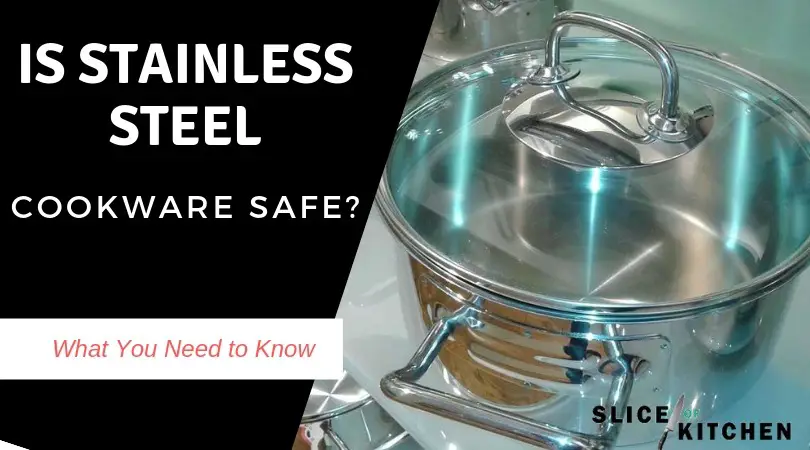Stainless steel is one of the materials that people often check when looking for non-toxic cookware. It is said to be inert and doesn’t leach harmful chemicals to the food. How true are these claims? Is stainless steel cookware really safe?
Stainless steel cookware is safe provided that you’re well-informed on how to choose one and how to safely use it. Nickel-free stainless steel cookware is the safest but they’re more prone to corrosion. They’re harder to find and more expensive too. 300 series stainless steel is good too as long as you don’t cook acidic foods in it that can cause leaching.
Nowadays, people are getting more interested in freeing their kitchen from toxins that can negatively impact their health. Cancer, dementia, liver inflammation, smaller newborn birth weight, and ulcer – these are just some of the illnesses that are linked to toxins that are found in some cookware.
Some of the most concerning types of cookware include Teflon-coated pans and cookware with an aluminum or copper surface. Teflon-coated pans have PTFE and PFOA which are both dangerous to the health. Aluminum cookware can cause leaching and is linked to Alzheimer’s disease. The same goes for copper which can also leach into your food and cause heart problems and even death.
Fortunately, there are still many other types of cookware that you can choose from like cast iron, glass, and today’s topic, stainless steel. There is a lot of debate surrounding stainless steel so today, I’ll try to shed some light on whether it is really safe.
Table of Contents
What Is Stainless Steel?
Stainless steel is a steel alloy which has 10.5% chromium at a minimum. It is lustrous and resistant to corrosion and staining by nature. To enhance its other qualities, alloying elements like nickel, molybdenum, titanium, and copper are added to it. To date, there are more than 150 stainless steel grades based on the combination of metals.
The Different Types of Food Grade Stainless Steel
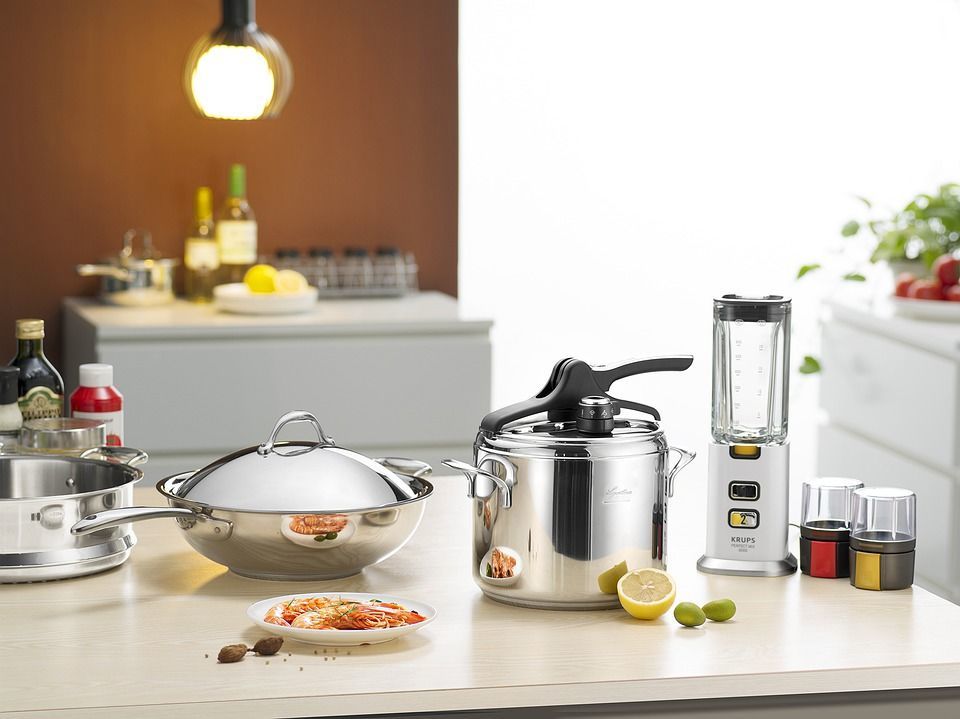
Based on the NSF International’s standard for food equipment, the SAE steel grades which are safe for food preparation are the following:
200 Series
In order to lower the cost of production, unreliable cookware manufacturers sometimes substitute part of the nickel component with manganese. Though cookware made from this non-magnetic series is cheap and is still rated as food grade, I recommend avoiding them because they are more prone to corrosion.
300 Series
There are two types of 300 series stainless steel that are considered safe for food preparation.
304 Stainless Steel
When it comes to cookware, the 304 SS is the most common stainless steel grade used. This non-magnetic material is very shiny since it has more chromium and nickel content. Compared to the 200 series, the 304 SS has better rust and corrosion resistance. Its disadvantage is that it has a tendency to rust when exposed to salt.
Sometimes, the flatware grading system is also used to describe 304 SS as 18/10 and 18/8. The first number pertains to the percentage amount of chromium while the second number is the percentage amount of nickel. So, in an 18/10 stainless steel, 18% of the alloy is chromium and nickel is at 10%. Likewise, stainless steel that has 18% chromium and 8% nickel is 18/8. Since the difference in nickel amounts between chromium and nickel is just 2%, the performance is almost the same and the difference is unnoticeable.
316 Stainless Steel
The 316 SS is high-end stainless steel that stands out for its excellent resistance to corrosion. In fact, it is also called marine stainless steel since it is even resistant to corrosion caused by exposure to salt and is often used in marine applications. The 316 SS has many medical uses as well and is known as surgical stainless steel.
What makes the 316 SS so durable is the addition of a small amount of molybdenum. It is composed of 16–18% chromium, 10–14% nickel, and 2% molybdenum. This makes this type of stainless steel quite expensive though, so there aren’t a lot of cookware that uses it.
400 Series
430 Stainless Steel
The 430 SS is a magnetic and nickel-free grade of stainless steel. In the flatware grading system, 430 SS is known as 18/0 since it has 18% chromium and almost 0% nickel.
Do note though that even if it’s legally acceptable to call it nickel-free, it still contains a negligible amount of nickel at about 0.75%. Because of the absence of nickel, 430 SS is more prone to corrosion and it tends to slowly lose its luster.
Is Stainless Steel Cookware Safe?
The answer is yes but there are a few things that you need to know before you can safely buy and use stainless steel cookware. Now, I know that’s frustrating but hear me out first.
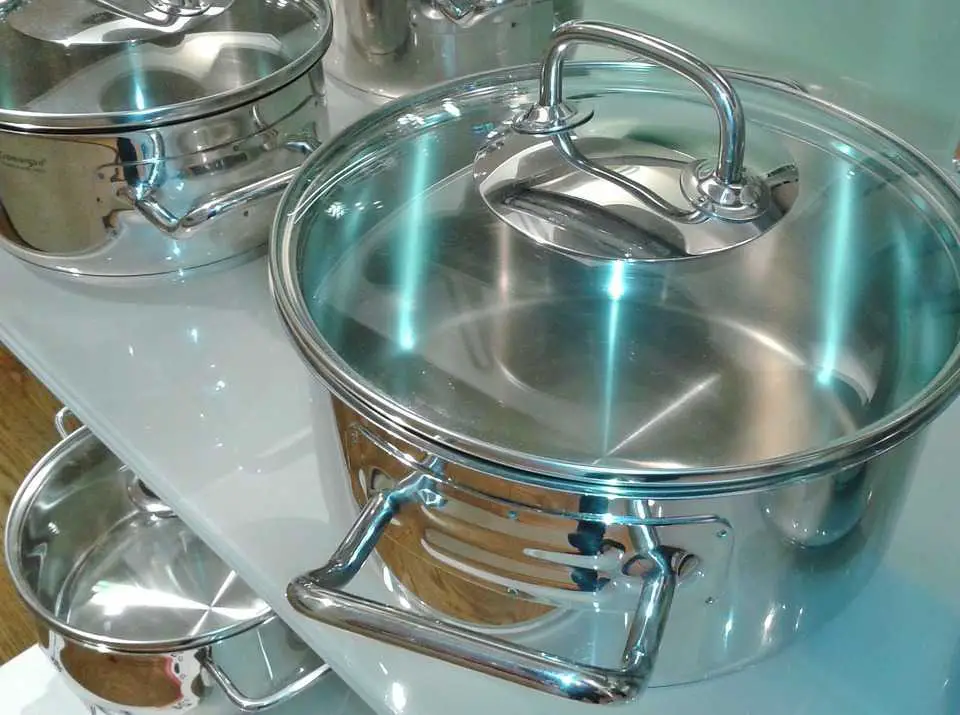
Stainless steel is considered by the US Food and Drug Administration (FDA) as safe for food contact as long as it has at least 16% chromium. Though it isn’t quite as inert as some people claim, it is still more stable and safer than other more reactive cookware like copper and aluminum.
Later, I’ll tell you some tips on how you can minimize your stainless steel cookware’s reactivity. First, let’s look at the issues concerning stainless steel as cookware.
Chromium Leaching
There isn’t an established tolerable upper intake level (UL) for chromium since the Institute of Medicine hasn’t found any hard evidence that links high levels of chromium to adverse effects. But, the recommended daily intake is 50 to 200 mcg for adults. So, our body actually needs small amounts of chromium. Unfortunately, most of the chromium that we need, we already get from foods like broccoli, potatoes, beef, poultry, dairy products, and apples.
This means that if our stainless steel cookware leaches chromium to our culinary creations, we might be getting more chromium than we need. And, according to a study in 2013, stainless steel cookware does leach chromium and nickel during the cooking process.
Nickel Leaching
Compared to chromium, nickel leaching is a much more serious issue since it’s right up there in the Substance Priority List (SPL) of the Agency for Toxic Substances and Disease Registry (ATSDR). We only need trace amounts of nickel in our body, and most of that we already get from foods like nuts, chocolate, and grains. Plus, kitchen appliances like crockpots and coffee machines which use stainless steel are additional sources too.
There’s research that supports the findings of the 2013 study that I’ve mentioned above. It states that stainless steel cookware can give us significant amounts of chromium, nickel, and iron. So, if you consider all the possible sources of nickel around us, we’re possibly getting much more than the 25 to 35 mcg of nickel that we need per day.
What happens when one is constantly exposed to high levels of nickel? There is a possibility of developing eczema, allergies, lung disorders, and cancer.
Minimizing Stainless Steel Reactivity
Since stainless steel cookware can contaminate food with chromium and nickel, does this mean that you need to stay away from them at all cost? Well, not really. Unless you’re highly sensitive to these metals, in which case you should explore other cookware options, you can still stainless steel cookware provided that you take special care in buying and using them.
- If you’re looking for stainless steel cookware that have less nickel in them, you can do the magnet test. Check if a magnet will stick to the sides, bottom, and inside of the stainless steel pot. If the pot is magnetic, it is nickel free.
- Sometimes stainless steel pots and pans have layers of aluminum in them which can cause aluminum leaching if exposed. So if you have stainless steel cookware, take special care to not to damage the surface. If that happens, it’s best to recycle it.
- To minimize the risk of nickel leaching, buy stainless steel grades like 18/8 or 18/0 which have lower nickel content. Ideally, you’ll want to get a 400 series stainless steel, but 300 series ones are okay too. Stay away from cookware labeled 200 series.
- Refrain from slow-cooking and cooking acidic dishes (i.e. tomato-based sauces) with your stainless steel cookware to prevent leaching.
- Remove the food right away from your stainless steel pan after cooking.
- Do not use abrasive detergents, scouring pads, and steel wool to clean it. If there are some food stuck to the pan, soak it in some water for an hour to soften it. You can also gently scrub it with a soft sponge and some baking soda. Alternatively, you can get something like the Bar Keepers Friend to clean your pans.
The Pros and Cons of Stainless Steel Cookware
Now that we’ve established that stainless steel is quite safe for cooking as long as you’re well-informed on how to choose, use, and maintain them, let’s talk about the benefits and drawbacks that they can bring to your kitchen.
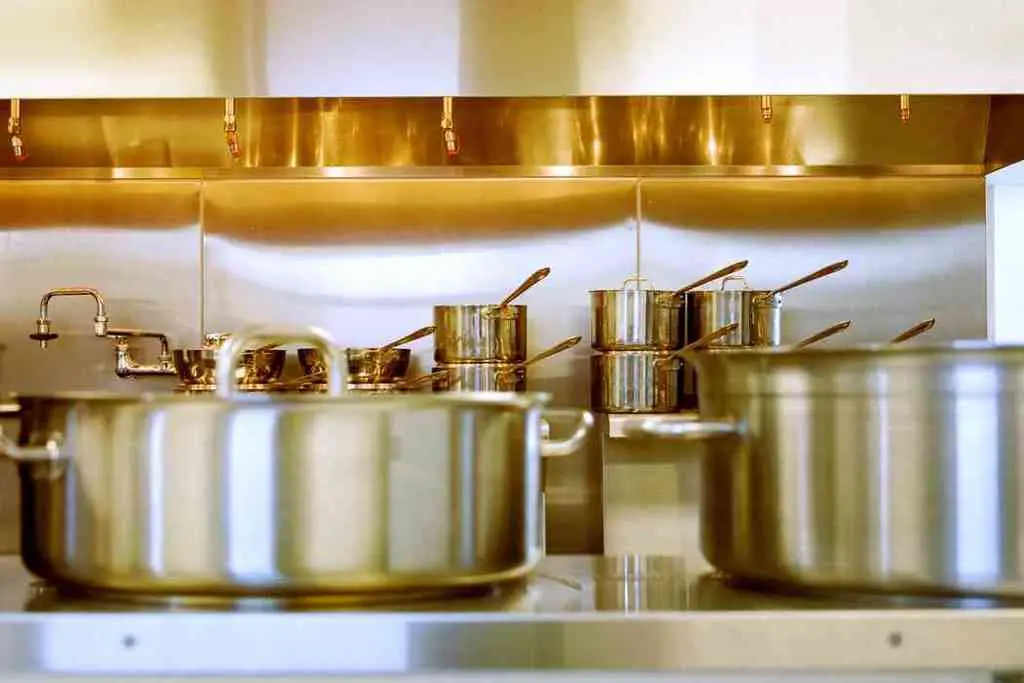
The Benefits
- Easy to clean and maintain
- Will last long if properly taken care of
- Magnetic stainless steel cookware work with induction cooktop
- Can be used in the oven and broiler and on the stove
- Comes in a wide variety of sizes and forms
- Relatively non-reactive with proper use
- Durable and resistant to rust, corrosion, scratching, and denting
- Has a polished appearance that would look good in any kitchen
- Completely recyclable
- Most cookware made of this material are dishwasher-safe
The Drawbacks
- Has a tendency to discolor when exposed to salty food at high temperatures
- Poor heat conductor, requires an aluminum or copper core to boost conductivity
- High-quality stainless steel cookware are expensive but will last you a lifetime
- Not nonstick, requires seasoning or good temperature control to prevent food from sticking
- Low-quality stainless steel pans might cause leaching
The Best Stainless Steel Cookware
Duxtop Professional Stainless Steel Cookware Set – Overall Best
- FOOD GRADE STAINLESS STEEL & STURDY: Duxtop stainless steel pots and pans are made of premium food grade 18/10 stainless steel, which keeps the flavor of the food. Heavy bottom with impact-bonded...
- FAST & EVEN HEATING: Heavy gauge impacted-bonded aluminum encapsulated bottom of the kitchen cookware set provides a quick, even and energy-efficient heating. Suitable for all stovetops, such as...
- FEATURES: Duxtop induction cookware feature a classic straight-sided and drip-free pouring design. The tight-fitting tempered glass lids allow cooking to be monitored while sealing in heat and...
For one of the best stainless steel cookware in the market today, check out the Duxtop 17-Piece Stainless Steel Cookware Set. Coming in at around $250 (time of writing), you get a higher quality product compared to other major brands like Calphalon and T-Fal at the same price.
The Duxtop set uses food grade 18/10 stainless steel, similar to many reputable stainless steel cookware. However, the 3 ply layers of each vessel is fused together using what the company calls impact bonding. No adhesive is used to combine the 3 layers, resulting in a longer lasting, safer finished product.
All cookware in the Duxtop set have an aluminum core in the middle, sandwiched by a stainless steel top layer and magnet steel layer at the bottom. This results in fast, even heating with no hot or cold spots. Now, you might be worried about aluminum leaching, but you don’t need to be. This aluminum core is embedded deep in the center.
Aside from safe cooking and even heat distribution, what else can the Duxtop Stainless Steel Cookware Set offer? Well, it is compatible with all types of cooktop including induction. This set is oven-safe too as long as the temperature doesn’t go over 550°F. Finally, it’s dishwasher-safe, so you can spend less time cleaning and more time enjoying your tasty creations.
One thing that I think would make this Duxtop set an even better product is the addition of steam holes in the lids. Since the lids that come with the set don’t have this feature, you have to place the lid askew when cooking to prevent the food from boiling over and making a mess.
Pros:
- Uses food grade 18/10 stainless steel
- Aluminum core with stainless steel outer layers for fast and even cooking
- Fused together without the use of adhesive
- Works for all types of cooktops
- Oven-safe
- Dishwasher-safe
- Handles stay cool
Cons:
- Food sticks unless temperatures is carefully monitored
- Lids do not have steam holes
All-Clad D3 Stainless Steel Set – Best Stainless Steel Skillet
- Experience professional-grade cooking with the All-Clad D3 Stainless 3-Ply Bonded Cookware 2-Piece Fry Pan Set, featuring 8 and 10-inch pans crafted for exceptional heat distribution, durability, and...
- Fast and Even Heat - D3 tri-ply is fully bonded to the rim for professional performance & durability. The high quality 18/10 stainless steel surface sears to perfection and is ideal to deglaze for pan...
- Design You Will Love - D3 has a professionally polished stainless steel finish. Our classic, double riveted stainless steel handles ensure a secure grip.
You no longer have to worry about toxins getting released in the air and into your food with the All-Clad D3 Stainless Steel Set. For under $200 (at time of writing), you can get US-made 8” and 10” stainless steel fry pans to assist you with high-heat cooking.
Unlike low quality non-stick coated pans which can contain PFOA and PTFE, the All-Clad D3 Fry Pans is completely chemical free. It doesn’t use any kind of coating. It does have an aluminum core to promote even heating, but there’s little to worry about leaching either. The aluminum core is sandwiched between two layers of 18/10 stainless steel.
The All-Clad D3 Set doesn’t falter when it comes to aesthetics either. The interior is beautifully polished while the exterior is mirror polished stainless steel. Not to mention that you can wash these pans using the dishwasher without diminishing its beauty.
It isn’t all good though. Since the All-Clad D3 Fry Pans are made of 18/10 stainless steel, it has a tendency to form small white dots when used to cook salty foods. Though it doesn’t affect the flavor of the food, it certainly isn’t pleasing to look at. To prevent pitting, I suggest that you only add salt once the liquids have started to boil.
Overall, I highly recommend the All-Clad D3 Stainless Steel Set if you want to safely and evenly apply high-heat cooking techniques to your food. Plus, the fact that these pans are quite versatile, pleasing to look at, and easy to clean are great bonuses.
Pros:
- Doesn’t release PFOA and PTFE under high heat
- Triply construction minimizes risk of aluminum leaching
- The aluminum core ensures even heat distribution
- Flared side make turning the food easier.
- Dishwasher-safe
- Handcrafted in the USA
- Has a beautiful mirror polished exterior
- Comes with a manufacturer’s lifetime warranty
Cons:
- Does not come with lids
- Has a tendency to pit
Homichef 14-Piece Nickel-Free Stainless Steel Cookware Set – Best Nickel-Free Stainless Steel Cookware
- 14-PIECE MIRROR POLISHED COOKWARE SET - Crafted from lustrous, brushed stainless steel and featuring clean lines and curvaceous silhouettes, this 14-piece cookware set blends well with your kitchen -...
- NICKEL FREE HARM FREE - Nickel-bearing stainless steel, being more corrosion-resistant, is commonly used in industry, BUT nickel is high up on the ATSDR list of priority toxins, and nickel LEACHES...
- NO COATING NO RISK - General non-stick coating cookware releases toxic fumes when cooking. The coating usually lasts only for 1-2 years, and thus it will eventually be eaten by the owner. Our...
If you want to use stainless steel cookware without having to worry about nickel leaching, the Homichef 14-Piece Nickel-Free Stainless Steel Cookware Set is the ultimate set to get. Thanks to its 3-ply construction, you can get energy-savings and even heating with this affordable and polished set.
This Homichef product stands out because it uses AISI 430 stainless steel or what is called 18/0 in the flatware grading system. That means that it doesn’t have nickel that can leach into your food and cause you allergies. According to the manufacturer, compared to cookware with nickel, you can get 12% to 15% energy savings with their product. Of course, the aluminum core embedded deep within the stainless steel layers helps a lot too.
Available for under $100 (at time of writing), the Homichef 14-Piece Set gives you good value for your money. Not only is it compatible with gas, induction, ceramic and halogen stovetops, it’s oven and dishwasher-safe as well. Its handles stay cool even during use and the flared rims make it easy to pour sauces without dripping. Plus, this nickel-free set has tempered glass lids that make it easy to check the progress of your dishes without opening the lid.
Another thing that I like about this product is that the manufacturer is quite thoughtful. One buyer even said that she really appreciated that the set came with detailed instructions on how to properly take care of them. She said that she liked that Homichef went the extra mile to ensure that the products lasted. Not to mention that the warranty is better than most stainless steel cookware out there. Not only do you get a 1-month free trial, it also comes with a 6-year warranty and free lifetime customer service.
The only thing fault that I can find about this Homichef product is its tendency to sometimes discolor. If you experience that, using a little bit of vinegar helps to remove it.
I highly recommend the Homichef 14-Piece Nickel-Free Stainless Steel Cookware Set for people wanting to eliminate toxins in their kitchen. It a good bang for your buck, one that will quickly be your favorite cooking partner. The polished silver exterior and the matte interior of the products are very pleasing to the eyes as well.
Pros:
- Uses nickel-free 18/0 430 grade stainless steel
- Offers consistent and even heating
- Riveted handles stay cool
- Has flared rims and tempered glass lids
- Works with with gas, induction, ceramic and halogen stovetops
- Oven and dishwasher-safe
- Comes with a 1-month free trial, 6-year warranty and free lifetime customer service
Cons:
- Sometimes discolors
- Pot is a little smaller than expected
Maxam 9-Element Waterless Cookware Set – Best Surgical Stainless Steel Cookware
- PROFESSIONAL-GRADE AFFORDABILITY: Maxam’s 9-Element T304 Surgical Stainless Steel 17-piece Waterless Set of Cookware is a stunningly beautiful collection of steam-controlled cookware that gives you...
- CUTTING-EDGE CRAFTSMANSHIP: Forged out of corrosive-resistant T304 surgical stainless steel to withstand erosive acids in fruits, vegetables, milks and meats, our high-quality waterless cookware...
- CONDUCTIVE EVEN HEATING: Spreading heat quickly and evenly throughout their 5-ply base, the temperature of our healthy cookware is controlled via Steam Control Valves which allow you to prepare your...
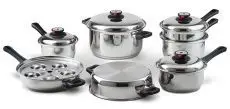
When it comes to durability, surgical stainless steel is second to none. So, if you want that level of durability in your kitchen, check out the Maxam 9-Element Waterless Cookware Set. Though it is more expensive than the products I’ve recommended, this beautiful and durable cookware will help you prepare healthy meals.
First, let’s talk about waterless cooking. Basically, it’s a style of cooking that doesn’t need oil and only require a very small amount of water. The steam control valve gives it an effect similar to that of low-pressure cooking. Not only will your vegetables retain more color, the meat gets seared at the bottom but quickly releases. Even the brown parts that get stuck to pan are easy to clean with a little bit of soaking.
The Maxam Waterless Cookware Set has excellent durability as well since it is made out of surgical stainless steel which is resistant to rusting and corrosion caused by exposure to salt. I even read a review of a satisfied buyer who has been using this set for more than 10 years. She said that even with daily heavy use, the set still looks wonderful and performs well. The pans can be placed in the dishwasher but I highly recommend that you wash the lids by hand to protect the steam control valve.
Its aesthetics is nothing to scoff at either. With a satin-finished interior and a mirror-finished exterior, they have a classic look that would go well in any kitchen. And, even if it’s not oven-safe, you can still use them on your induction stovetop.
The drawback to using the Maxam Waterless Cookware Set is that it has a learning curve. It doesn’t come with instructions on how to properly use it so there’s a bit of guesswork the first few times you use it.
Once you get past the learning curve, you can expect to cook healthy and delicious meals for years with the Maxam 9-Element Waterless Cookware Set. Beautiful and durable, it is a product that you won’t regret buying.
Pros:
- Made of durable surgical stainless steel, resistant to rust and corrosion caused by salt
- Has no hotspots
- Has steam control valves for waterless cooking
- Exterior has an elegant mirror finish
- Handles don’t get hot
- Pots and pans are dishwasher-safe
- Induction-compatible
Cons:
- Expensive compared to other cookware on this list
- Lids aren’t dishwasher-safe
- Not allowed for oven use
- Hard to use at first
Frequently Asked Questions About Stainless Steel Cookware
Is Stainless Steel Dishwasher Safe?
This is a tricky question. Some manufacturers say that their products are dishwasher-safe but others say that it’s better to wash them by hand.
Well, the problem is that the detergent might be too harsh and that the acidic food spoil from other kitchenware might damage the finish of your stainless steel cookware. So, I suggest just manually washing them to prevent leaching and to increase its lifespan.
If you still want to use your dishwasher to clean your stainless steel pots and pans, it’d be better to put them in in the upper rack or cutlery basket. This way, they are far from other materials and can be washed properly.
Is Stainless Steel Nonstick?
Unfortunately, stainless steel isn’t nonstick. Food will stick to it if you don’t properly control the temperature before adding your ingredients. Also, just like cast iron pans, stainless steel pans can be seasoned to prevent food from sticking.
Leidenfrost Effect
The water droplet trick, or what is scientifically known as the Leidenfrost effect, is very helpful in knowing if your pan has reached the right temperature to add oil to it.
Once you think that your pan is hot enough, add a drop of water to the pan and check what happens to it.
- If the water bubbles up and then quickly evaporates, your pan is still too cold.
- If your pan is too hot, the water will split into smaller droplets and skitter across the pan before evaporating.
- You’ll know if your pan is nearing the right temperature if the water splits into smaller droplets before evaporating.
- The temperature is right if the water doesn’t split and moves around the pan.
Check out this video to see the water droplet trick:
How to Season a Stainless Steel Pan
As I’ve mentioned above, you can season your stainless steel skillet to prevent food from sticking to it. Here’s how you can do it.
- Using medium heat, heat your pan for a couple of minutes.
- Add some high heat oil and swirl it around the pan to coat the sides.
- Once the oil is smoking, you can turn off the heat and allow the pan to cool down.
- Remove the oil and wipe the excess oil with a paper towel.
Here’s a very helpful video that you can follow when seasoning your stainless steel pan. It even includes a short demonstration showing the fried egg test:
Is Stainless Steel a Good Conductor of Heat?
By itself, stainless steel doesn’t conduct heat well. This is why stainless steel cookware often have aluminum or copper cores that help it evenly and quickly.
Are Stainless Steel Cookware Compatible with Induction Cooktops?
Some stainless steel cookware are compatible with induction cooktops but some aren’t. Induction cooktops take advantage of the power of magnetism. Thus, the cookware must be magnetic.
Stainless steel cookware with high nickel content aren’t magnetic. So, if you’re using induction cooktops, you need to buy stainless steel pots and pans that have low nickel content. Look for 18/4 and 18/0 grades.
Can Stainless Steel Rust?
Stainless steel has better resistance to rust than other cookware materials like cast iron and carbon steel. But, just because they have excellent resistance to this type of corrosion, doesn’t really mean that they can’t rust. In the event that your stainless steel pots and pans form rust, just make a paste out of some baking soda and water. Then, use a toothbrush or a soft cloth to gently scrub it on the rusty area. Since baking soda isn’t abrasive, it won’t damage the surface of your stainless steel cookware but will still effectively remove the rust.
You can also check out this video to see how to remove rust from stainless steel pans with some baking soda:

